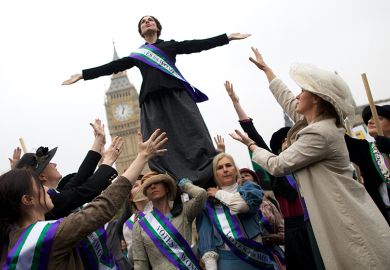Feminist scholarship of the past 30 years has accomplished fundamental changes in our understanding of cultural history. As the significance of women's lives and work has been more recognised, the paradigms of history, social science, literary criticism and the history of art have been decisively revised, resulting in substantial reassessment of the critical and historical record. We are now entering a period of consolidation, in which the contribution of preceding generations is absorbed into the contemporary mainstream and the polemical impulse of earlier work is channelled into detailed reappraisals.
The eclectic and insightful Streetwalking the Metropolis is a fine example of such work. Deborah Parsons's achievement is to draw from a range of critics, in a variety of disciplines, to produce a new perspective on the nature of literary modernism in the period 1880 to 1945.
Parsons concentrates on women's responses to the changing psychic, social and geographical spaces of London and Paris. The struggle to generate idioms and forms appropriate to the new, disorienting experience of metropolitan culture has long been recognised as a determinant force in modernist writing, both in literature and in the social sciences, but from Poe's Man in the Crowd to Baudelaire's flâneur , through Prufrock and Bloom, to Georg Simmel and Walter Benjamin, the consciousness of the city was typically, in Raymond Williams's phrase, the consciousness of "a man walking, as if alone, in its streets". Parsons contends, however, that despite the constraints on their access to the city and freedom of movement, women were profoundly attuned to the turbulent evolution of the urban environment, and their modes of expressing this were crucially distinct. Tracing her theme through the work of Amy Levy, Dorothy Richardson, Virginia Woolf, Rosamund Lehmann, Jean Rhys, Janet Flanner, Djuna Barnes, Anais Nin and Elizabeth Bowen, Parsons explores their "self-conscious positioningI as living and working in relation to a tradition of urban representation". In contrast to the confident, synoptic figures of their male counterparts, these women developed an image of the female urban walker "as elusive and ambiguous, as the flaneuse or passante who walks away from the categorising, possessing gaze of the masculine observer".
Streetwalking the Metropolis is a convincing and assured performance, but there are omissions and lapses. The principles behind the selections are not always clear (why no Margaret Harkness?); there is sometimes insufficient differentiation between Paris and London; chronology becomes confused at a couple of points; and the work would benefit from more extensive reference to recent collateral historical studies (for instance by Martha Vicinus, or Sally Alexander). Parsons's style occasionally falls into jargon and needless neologism, and her syntax can be tortuous. Slips in referencing and repetitions are also unusually frequent for an Oxford University Press monograph. But these are minor irritants within a sustained, coherent presentation.
Parsons has contributed significantly to the debates around women's experience of modernity, and reiterated the importance of these particular writers - writers often relegated from the (male-dominated) canon of modernism. The book will find a readership not only among specialists across the relevant disciplines, but also among students and general readers eager to explore alternatives to the traditional Pound-Eliot-Joyce axis: that OUP has published both hard and paperback editions testifies to this broad appeal.
Sean Matthews is lecturer in English, University of Wales, Aberystwyth.
Streetwalking the Metropolis: Women, the City and Modernity
Author - Deborah L. Parsons
ISBN - 0 19 818682 7 and 818683 5
Publisher - Oxford University Press
Price - £35.00 and £13.99
Pages - 256
Register to continue
Why register?
- Registration is free and only takes a moment
- Once registered, you can read 3 articles a month
- Sign up for our newsletter
Subscribe
Or subscribe for unlimited access to:
- Unlimited access to news, views, insights & reviews
- Digital editions
- Digital access to THE’s university and college rankings analysis
Already registered or a current subscriber?



